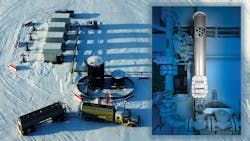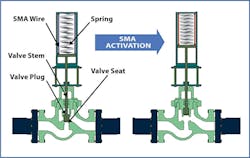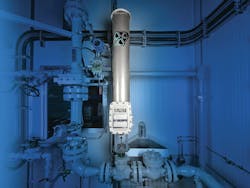Electric Valve Actuator Proves Suitable Alternative to Methane-Venting Pneumatics
Kinitics Automation, a developer of advanced motion control solutions, recently announced its KVA38 electric valve actuator proved successful in a field demonstration at a remote natural gas wellsite.
The KVA38 electric valve actuator is designed to provide an alternative to methane-venting pneumatic actuators commonly used for valve control in the energy sector. It provides high force and precise linear motion while also reducing the release of methane emissions into the atmosphere during natural gas production, which is one of the challenges associated with methane-venting pneumatic actuators.
Field testing of the electric valve actuator was conducted at a wellsite near Edson, Alberta, Canada, as part of the NGIF Emissions Testing Centre (ETC) Program which supports development of technologies created to help monitor and reduce methane emissions.
Per Kinitics Automation, three actuators were used to control critical dump and backpressure valves within a multi-phase separator system. The actuators achieved over 10,000 cycles across 160 days of continuous operation, helping to demonstrate the large-scale deployment capabilities of the KVA38 in natural gas production facilities.
“Through this successful commercial product trial, the KVA38 has been validated for widespread deployment and adoption,” said Dean Pick, President and CEO of Kinitics Automation. “This initial deployment is estimated to reduce CO2e (carbon dioxide equivalent) emissions by 91 tonnes annually, and we are continuing to place additional units in the field to eliminate methane venting from natural gas facilities. The NGIF Emissions Testing Centre Program has been instrumental in de-risking innovative clean technologies like the KVA38, providing field trial opportunities that accelerated the path to commercialization.”
How the KVA38 Electric Valve Actuator Works
Kinitics Automation began developing its KVA38 electric valve actuator in 2019 after being approached by the Natural Gas Innovation Fund, a clean technology arm of the Canadian Gas Association, about the challenges associated with methane-venting pneumatics, namely that this technology was releasing methane into the atmosphere during natural gas production.
Why are methane emissions bad?
Methane is a greenhouse gas (GHG) which contributes to air quality issues which can negatively impact human health and the environment. Per the International Energy Agency (IEA), methane has a shorter lifespan in the atmosphere than carbon dioxide (CO2) but absorbs more energy during its life.
Methane can enter the atmosphere from natural sources and human activity. IEA currently estimates 40% of annual methane emissions can be attributed to natural sources and the remaining 60% from human activity with agriculture and the energy sector being the largest contributors.
“Once we dug into the problem of methane venting, we came to appreciate that there’s equipment, pneumatic valve actuators in particular, that are designed in a way where they're using the gas from the pipe, essentially from the ground, as a source of compressed gas,” explained Pick in an interview with Power & Motion. “The way that they're using it is to consume or use the pressure for useful work. But they don't combust the gas. So, after the valve actuator does its job, it's releasing, sometimes in puffs or sometimes in a continuous way, methane into the atmosphere.”
He said the energy sector wants to phase out use of this technology to mitigate methane emissions and so is turning to companies like Kinitics Automation for potential alternatives.
Pick said the company set out to develop a general-purpose globe valve actuator capable of addressing a good portion of the equipment currently running in the field operating on a methane-venting strategy. The result is the KVA38 which is fully electric and utilizes Shape Memory Alloy (SMA) technology for precise linear motion as well as reliability. SMA is a special type of material that can change its shape when it undergoes a temperature change; for the KVA38 this is done using electric current.
Inside the KVA38 valve actuator is a bundled wire assembly comprised of biasing spring and SMA wires. When an electric signal is sent to the actuator, it excites the SMA to control the length of the wire assembly. By expanding or contracting the wire assembly via electric current, the global valve coupled to the actuator can be opened and closed as required.
Pick explained that when the actuator is idle, the spring uses that force to hold the globe valve in a closed position. “When we want to open the valve, we flow electricity through the SMA material. It compresses the spring, lifting the valve plug off the seat, allowing gases to flow.”
This design helps to maintain safety as well because the force of the spring keeps the valve in a closed position until an electric current is supplied to the actuator. So, if a natural gas production facility should lose power, the valve will remain in a closed position, ensuring no emissions escape.
“It’s a very controllable technology,” he continued. “We can set the position extremely fine, so 50 microns or 2,000ths of an inch, and this allows for modulation of throttling gases or fluids through the valve.”
Due to its design, the KVA38 is suitable for controlling any kind of fluid flow, liquids or gases, said Pick. “It is quite suitable for a variety of general-purpose tasks — level controls on tanks, pressure control on a system, flow control through a pipe or temperature control on a vessel,” he said. “We’re really trying to position this as the best option for any kind of general-purpose process control application.”
Pick went on to say that the KVA38 has a simplified architecture with no metal-to-metal contact, helping to minimize potential maintenance or failure points. “It’s basically a floating design with one moving part; the only that’s touching the valve stem on our end is a wiper seal to keep out dust, debris, [and other contaminants],” he said.
The KVA38 electric valve actuator is designed to withstand use in harsh operating conditions and is certified for Class I Zone 1 hazardous locations, those in which flammable gases or vapors may be present, in the U.S. and Canada. It can be used in temperatures as low as -40 C, aiding use in remote oil and gas operations.
Watch our video interview with Dean Pick of Kinitics Automation below to learn more about the design of the KVA38 electric valve actuator and the various benefits it offers.
Steps to Follow When Moving from Pneumatic to Electric Valve Actuation Technology
If choosing to switch from pneumatic valve actuation to an electric alternative, Pick said the first step should be sizing the valve that will be utilized. “The valve itself needs to be selected and sized in a way that suits the process,” he said. “Do not start at the actuator and work backwards.”
When sizing globe valves, the two most important aspects that need to be taken into consideration whether using a pneumatic or electric valve actuator technology are thrust — the equivalent term for force when discussing globe valve technology — and lift height. Lift height refers to how much height is needed when the valve is fully open; limited or partial lift are also considerations in some applications.
Once these valve specs are determined, an actuator can be selected. If choosing to use an electric valve actuator, power source is the next factor that needs to be taken into consideration. Does the production site use 20 or 24V, or another voltage? Is there even electricity on site for use? “This will either set up a site requirement to have the infrastructure there, or it may [determine] selection of a valve actuator to suit the power that's already available,” said Pick.
From here control system selection can be undertaken. Analog and serial connections are possible with the KVA38 due to its built-in positioner, enabling use of closed loop control. This makes it possible to know where the valve needs to be at any point while also allowing for particularly fine control and data collection when desired. Pick said it is one thing to be able to communicate to the valve to open 50% but another to receive positive feedback that the valve is actually open and at the required 50%. Doing so assures users the valve is performing as desired for a given application.
Pick notes that when choosing a valve actuation technology, it is important to run a cost-benefit analysis. As the size of a valve gets larger, the cost of the actuator that will be used with it goes up. He said that if dealing with an exceptionally large valve that does not move very often, the cost-benefit analysis may show a pneumatic actuator is the better option. Aspects such as setting up any necessary infrastructure should be part of the analysis as well.
Regulations and Improved Operations Driving Transition to Electric Valve Actuators
According to Pick, the natural gas industry — everyone from production through to midstream and even downstream operators — have become accustomed to using methane-venting devices. But they are now facing regulatory pressure to use alternative technologies to prevent the release of methane emissions associated with these devices.
Whether at the state, provincial or federal level, he said there are laws and regulations in place preventing use of methane-venting devices at new sites. There are also some stipulations “on units that are out there in the field, restricting how much they can vent and, in a few jurisdictions, completely banning the use of methane-venting pneumatics,” said Pick.
Although driven by regulations, he said there are advantages which can be realized when transitioning away from the pneumatic devices. “Not only does it reduce [a site’s] overall emissions profile, which quite a few companies have to report on, but it gives them an opportunity to basically electrify a site and get some of the advantage of a more automated, more connected process control system,” said Pick.
He noted there are upfront costs associated when making such an upgrade to a facility, depending on what infrastructure already exists, but some of the maintenance and enhanced productivity benefits associated with doing so can help offset those costs. “Ultimately, there’s a payback opportunity for these customers,” he said. “A few of the first movers we’ve seen in the industry are already realizing those benefits.”
When looking at the compressed air systems used at sites in the energy sector, Pick said they often require complicated and distributed infrastructure that includes a number of components such as compressors, storage tanks, dryers, filters, regulator distribution lines and more. All of these require routine maintenance while also presenting multiple leak points which can contribute to higher energy use and cost, among other issues.
“By moving to an electric device, you eliminate all this fairly maintenance intensive infrastructure that can also lead to unplanned downtime,” he said. “These can add up and give some reasons to start considering a fully electrified site that doesn’t require these pneumatic distribution systems.”
Going forward, these benefits and continued regulatory pressure are likely to increase the uptake of alternatives to methane-venting pneumatic devices like the KVA38 electric valve actuator.
The KVA38 is also just the start of several valve control, process control and automation products Kinitics Automation intends to develop utilizing SMA said Pick. With this material, he said “we have the ability to develop force in a linear motion, a rotary motion, and sometimes in very complex motion control profiles. There’s some very interesting benefits and value propositions that it can introduce to complement other technologies out there, like motors, hydraulics, etc. “It definitely has a place and a part to play in automation and process control,” he concluded.
About the Author
Sara Jensen
Executive Editor, Power & Motion
Sara Jensen is executive editor of Power & Motion, directing expanded coverage into the modern fluid power space, as well as mechatronic and smart technologies. She has over 15 years of publishing experience. Prior to Power & Motion she spent 11 years with a trade publication for engineers of heavy-duty equipment, the last 3 of which were as the editor and brand lead. Over the course of her time in the B2B industry, Sara has gained an extensive knowledge of various heavy-duty equipment industries — including construction, agriculture, mining and on-road trucks —along with the systems and market trends which impact them such as fluid power and electronic motion control technologies.
You can follow Sara and Power & Motion via the following social media handles:
X (formerly Twitter): @TechnlgyEditor and @PowerMotionTech
LinkedIn: @SaraJensen and @Power&Motion
Facebook: @PowerMotionTech




